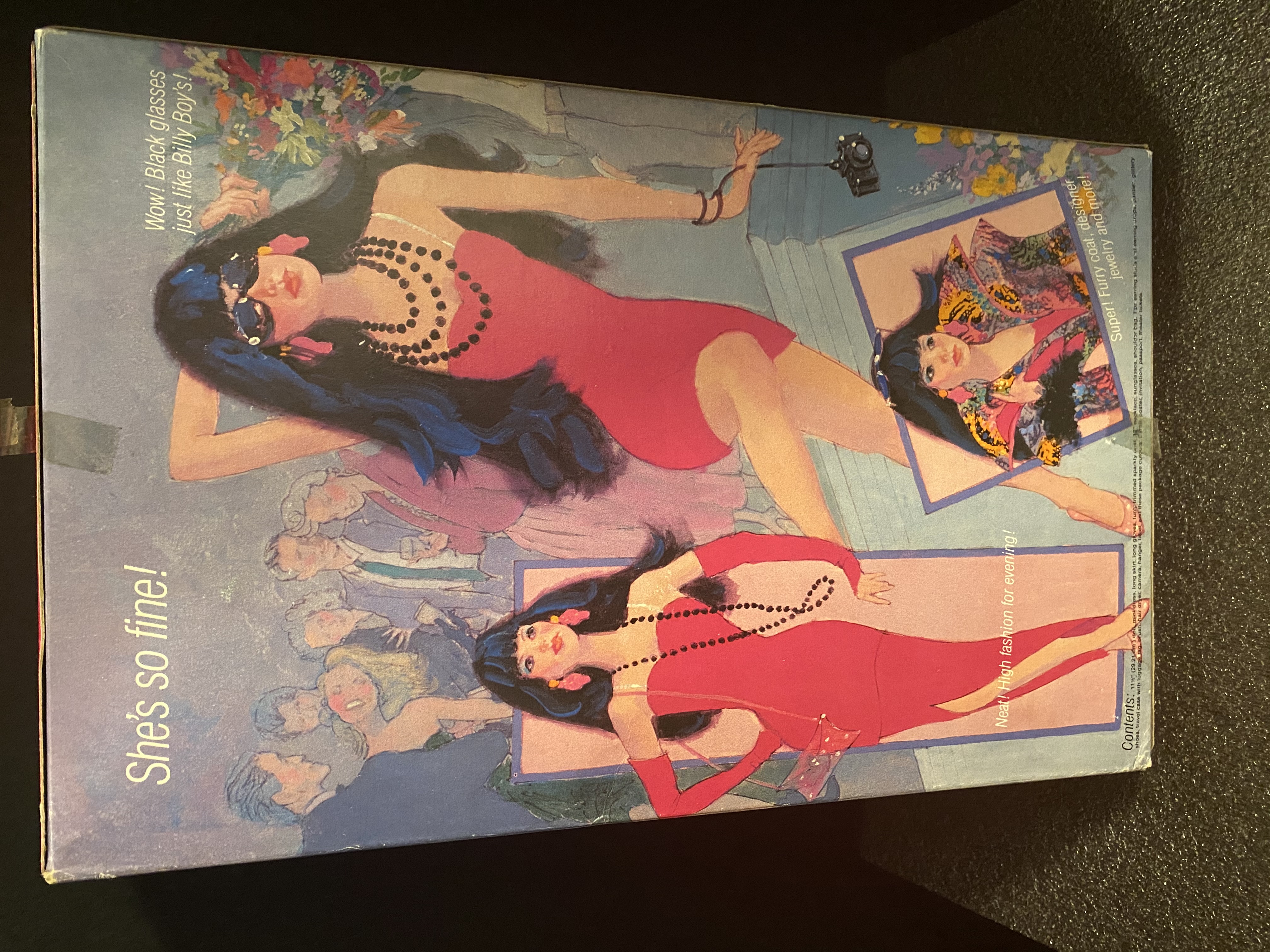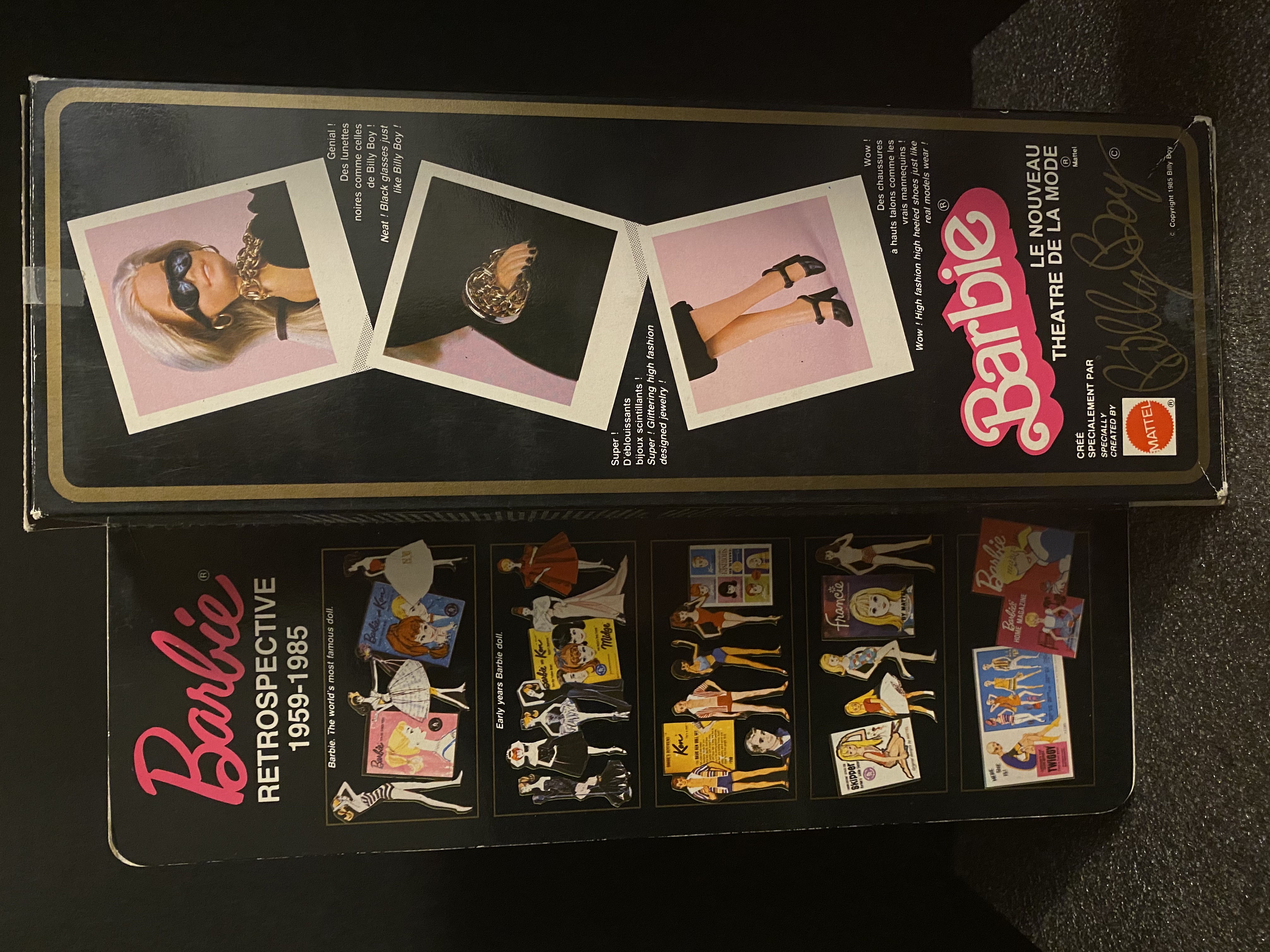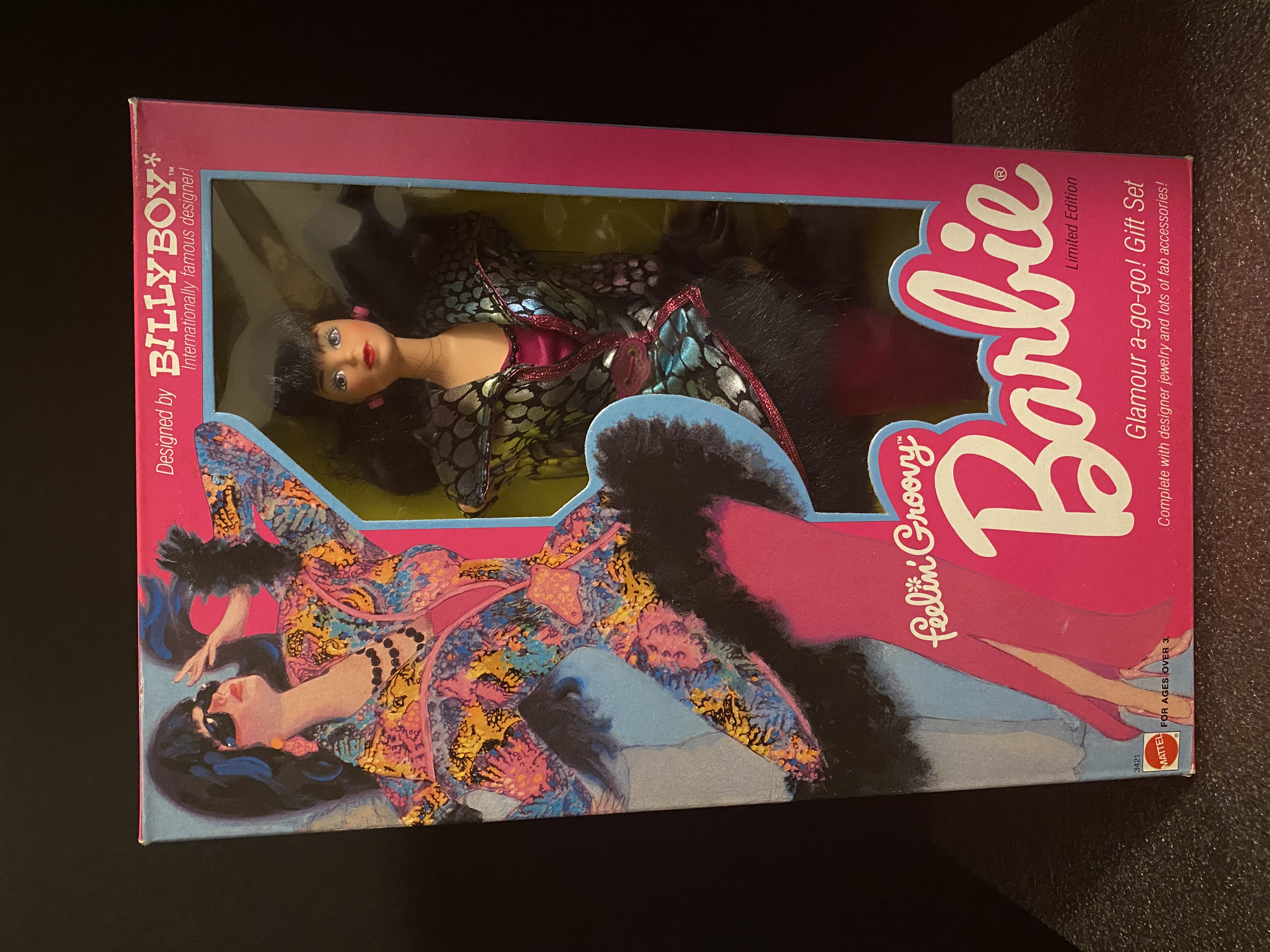
Frank New is a queer, non-binary, multi-hyphenate artist based in New York. Frank is currently a PhD Candidate [Fashion Studies] at Massey University in Wellington, New Zealand. Frank’s research path focuses on Queer doll history, ‘Queer’ Barbie, and doll play through a queer lens. Frank holds a Master of Arts in Costume Studies from New York University. @ManYourStyle
The following is an excerpt from my dissertation on ‘Queer’ Barbie and queer doll history, from a chapter that tells the stories of four queer collaborators who have all designed at least one or multiple dolls for the Mattel brand, Barbie. The focus of this chapter is Billy Boy, a queer artist and designer who gained notoriety with Barbie and her friends in the 1980s, becoming the first designer to have his name included on the packaging. A whirlwind tour around France in 1985 and the US, celebrating Barbie’s then 26th anniversary, included over-the-top fashions from top designers such as Yves Saint Laurent and Karl Lagerfeld.
Billy Boy, artist, designer, Barbie fanatic, and often muse of Andy Warhol. There are many facets of the life and career of Billy Boy, across multiple categories including fashion and jewelry design, into which were woven his love for Barbie in some shape or form. The article “Billy Boy Just Bonkers Over Barbie,” written in 1985 by Fashion Editor Genevieve Buck for the Chicago Tribune, discusses how museum officials considered Billy Boy's collection of couture clothes to be one of the largest privately owned collections in the world. [1] Within Boy’s collection were 10,000 examples of French, Italian, English, and American high fashion, not including his personal designs. His own initial design work began with hats under the label ‘Millinery Madness,’ and at age 16 he further developed this concept into a New York City–based storefront called Surreal Couture. Buck mentions that the majority of Boy’s collection was acquired by museums such as The Metropolitan Museum of Art, the Louvre, and the Victoria & Albert Museum in London. In the donation to The Met, Billy Boy included a black jacket with one sleeve, possibly in black satin as a contrast, olive-colored fringe on each sleeve to the neckline, and a red plastic lobster across the chest. The Met also acquired some of Boy’s jewelry including a pin, ornate in detail, metal with stones, pearl detail, and what appears to be a beak that holds a pearl. Boy’s donation to the Victoria & Albert Museum included a long royal blue dress with pirate sleeves and a vibrant pink ruffled collar. The first Barbie doll Billy Boy designed for Mattel included miniature versions of original Billy Boy jewelry such as the chunky gold neck chains and arm bracelets.
While examining the many facets of Billy Boy’s life, his adornment of all things fashion and Barbie merge in a seamless marriage that is filled with sequins and the flashiest couture fashion from the biggest designers of the 80s. His life, far from ordinary or simple, captured the attention of fashion designers and celebrities; he was a muse to Andy Warhol, whose offers to paint his portrait he famously turned down multiple times. In the end, Warhol took one of Billy Boy’s Barbie dolls and turned it into his portrait, titled, ‘Portrait of Billy Boy,’ one of the artist’s final pieces, completed in 1986. A second version of the painting, with a red and orange painted background, was made for and purchased by Mattel and still hangs in the corporate offices.
Billy Boy was a name synonymous with Barbie by the 1980s, thanks to a whirlwind stint at Mattel that produced two Barbie dolls. He became the first designer and queer person to have their name on the packaging.
Billy Boy, artist, designer, Barbie fanatic, and often muse of Andy Warhol. There are many facets of the life and career of Billy Boy, across multiple categories including fashion and jewelry design, into which were woven his love for Barbie in some shape or form. The article “Billy Boy Just Bonkers Over Barbie,” written in 1985 by Fashion Editor Genevieve Buck for the Chicago Tribune, discusses how museum officials considered Billy Boy's collection of couture clothes to be one of the largest privately owned collections in the world. [1] Within Boy’s collection were 10,000 examples of French, Italian, English, and American high fashion, not including his personal designs. His own initial design work began with hats under the label ‘Millinery Madness,’ and at age 16 he further developed this concept into a New York City–based storefront called Surreal Couture. Buck mentions that the majority of Boy’s collection was acquired by museums such as The Metropolitan Museum of Art, the Louvre, and the Victoria & Albert Museum in London. In the donation to The Met, Billy Boy included a black jacket with one sleeve, possibly in black satin as a contrast, olive-colored fringe on each sleeve to the neckline, and a red plastic lobster across the chest. The Met also acquired some of Boy’s jewelry including a pin, ornate in detail, metal with stones, pearl detail, and what appears to be a beak that holds a pearl. Boy’s donation to the Victoria & Albert Museum included a long royal blue dress with pirate sleeves and a vibrant pink ruffled collar. The first Barbie doll Billy Boy designed for Mattel included miniature versions of original Billy Boy jewelry such as the chunky gold neck chains and arm bracelets.
While examining the many facets of Billy Boy’s life, his adornment of all things fashion and Barbie merge in a seamless marriage that is filled with sequins and the flashiest couture fashion from the biggest designers of the 80s. His life, far from ordinary or simple, captured the attention of fashion designers and celebrities; he was a muse to Andy Warhol, whose offers to paint his portrait he famously turned down multiple times. In the end, Warhol took one of Billy Boy’s Barbie dolls and turned it into his portrait, titled, ‘Portrait of Billy Boy,’ one of the artist’s final pieces, completed in 1986. A second version of the painting, with a red and orange painted background, was made for and purchased by Mattel and still hangs in the corporate offices.
Billy Boy was a name synonymous with Barbie by the 1980s, thanks to a whirlwind stint at Mattel that produced two Barbie dolls. He became the first designer and queer person to have their name on the packaging.
 Back of the Billy Boy Barbie box. Photo courtesy Frank New.
Back of the Billy Boy Barbie box. Photo courtesy Frank New.Billy Boy, Barbie, and an exhibition
In this section, my research focuses specifically on Billy Boy’s obsession with Barbie and concludes around the exhibition that traveled France on a train celebrating Barbie’s 26th birthday in 1985. For context, components of Billy Boy’s background and home life are exposed through a visual description of his Paris apartment, providing a better understanding of Boy’s overall aesthetic. Furthermore, this section explores Boy’s personal fashion collection and his first love, Schiaparelli. Fashion editor Genevieve Buck, cited above, interviewed Billy Boy from his home in Paris.
The article starts out by prefacing that this will not be your traditional, expected interview; Buck begins with, “He is not exactly the boy next door.” [2] The writer describes Billy Boy's obsession, his true love “with a bosomy young blond and older woman” (presumably she is referring to Barbie here). There is mention of Billy Boy owning thousands of dresses, dresses that are tucked away all over the world in warehouses and museums due to the lack of space in his apartment. Buck then mentions that Billy Boy made cookies, but instead of using chocolate chips, he used color stones, and then sells them at $80 a piece. This opening paragraph underscores the opulence that is associated with Billy Boy as an artist and designer. Buck describes Billy Boy acquiring enough discarded Barbie dolls to fill ten steamer trunks while on a trip to Chicago. Barbie is at the top of the list when it comes to the loves of his life, and he expresses to Buck, “Barbie dolls are what makes his world go ’round.” [3]
At the time of this interview, Billy Boy was 25 years old, though his passion for Barbie began around age two. Barbie was 26, just a year older than Billy Boy, and the designer had been planning an international celebration of her birthday that included 400 of his vintage Barbie dolls that would go on tour around France on a train. The article mentions this tour possibly extending through Europe and New York. It did eventually make its way to the United States with one stop in New York City. During this time there are vague details of a book about Barbie likely to be published by Doubleday with hopes to be edited by Jacqueline Onassis. Some of Billy Boy’s inspirations include Schiaparelli, Vionnet, Poiret, Saint Laurent, Chanel, Ken, and Barbie of course.
Buck probes for details on Billy Boy’s childhood but is given little details and finally Billy Boy responds with this witty statement,''What matters is where I am now. Just say that I was abandoned--left on a doorstep in a lime-green groovy vinyl basket, with a little shoe hat perched on my head and a little Barbie in my hand, wearing an enormous `40s cocktail ring.'' [4] Buck feels that the doorstep description suits Billy Boy well, a mystery figure whose interests revolved around a doll, jewelry, and offbeat wearables. Billy Boy is described as wearing “piles of pearls” layered with additional necklaces and a touch of eye makeup.
The article describes Billy Boy’s apartment containing an etagère filled with jewelry, handbags, glasses, and other mementos of Elsa Schiaparelli, who is described as “the other woman” in Billy Boy’s life. The rest of the apartment has vintage furniture from various time periods and bits of steel here and there.
Billy Boy goes on to talk about his connection to women and how important it is to him to make women feel beautiful. He says,”But my life isn't what matters. The only thing that matters is that I just want to make women feel beautiful. That's why I like making jewelry, clothing. That's why I collect clothing. I'm obsessed by the beauty of women, fascinated by the mystery of women.” [5]
Buck continues, “he rhapsodizes with references to Isadora Duncan, Sarah Bernhardt, Elizabeth Taylor, Pavlova, Schiaparelli and his ‘muse’ legendary mannequin Bettina Graziani.” [6] The story continues with a few more details of his childhood including the fact that he was adopted, his adoptive mother was a professional gambler, his adoptive father was a cowboy, and his real name is Billy Boy. He was named after grandfather Wilhelm, who went by Billy Boy.


The French exhibition included a commemorative Barbie doll designed by Billy Boy himself for the momentous occasion. The design aesthetic speaks directly to his flamboyant nature. Billy Boy became the first celebrity guest designer to have his name prominently displayed on the doll’s packaging.
Le Nouveau Théâtre De La Mode, 1985
Billy Boy’s first design for Barbie , the doll wears a long black dress, jet black sunglasses, chunky neck and arm jewelry, a simple pair of gold-hoop earrings, a strappy pair of heels, and blonde hair pulled tight on the head into a ponytail. The box features assorted historical images of early Barbie and Ken dolls, the title of the retrospective, and includes Billy Boy’s name on the packaging. The gold chains that adorn Barbie’s neck are synonymous with classic Billy Boy–style jewelry and are inspired from personal designs that have been retrofitted into miniature versions.
The French designer Yves Saint Laurent is responsible for the most looks made for the traveling exhibition with over ten looks, all derived from adult-size YSL runway looks, made into miniature couture versions. Within the French exhibition catalog that accompanies the tour, Yves Saint Laurent wrote the following,
“It was with surprising pleasure, thanks to Billy Boy, that I discovered the elixir of my childhood again. For it was by making clothing for my sister’s dolls that it all began. As one can see, my apprenticeship started quite early, and even though I may have learned a lot since, I can never forget those privileged moments by the Mediterranean Sea, when I first discovered the secret of an art which was to engage my whole life. I have never seen dolls since without thinking of that period of my life when I believed that clothes were just part of a wonderful game, with colors and fabrics playing together in endless happiness. I’ve learned since then how difficult this craft is, because if it gave me many great joys, it also gave me great doubts and anguish. I hope with all my heart that these dolls attract today’s children and that they can find, through dolls, the road to their vocations.” [7]
“Barbie dolls are what make [Billy Boy’s] world go ’round.”
Additional details of his childhood include that it revolved around sketching and collecting. Buck mentions that at age 4, he made his first piece of jewelry, a bracelet of seashells, masking tape, rope, and feathers. Further to his love of Schiaparelli, at age 12, Boy purchased a bonnet dated from 1936 for just fifty cents, and the designer served as inspiration for a long time. He goes on to discuss this “obsession,” referring to Schiaparelli as a “spiritual guide,” collecting over 2500 objects including jewelry, gowns, and the very first “Shocking” perfume bottle. Buck revealed that a retrospective took place in Paris in 1984 highlighting the objects collected by Billy Boy. His Schiaparelli collection pales in comparison to his Barbie collection, with doll counts reaching the many thousands including “hundreds of her family members too,” Buck says. [8]
The article goes on to mention the exhibition that traveled France in 1985, sponsored by Mattel, on a train touring several cities and featuring 400 of Billy Boy’s favorite Barbies. Buck describes several of the outfits, with designs made specifically for this exhibition by designers such as Yves Saint Laurent, Jean-Paul Gautier, and Karl Lagerfeld. In total, fifty high-profile designers contributed miniature garments for Barbie to model as well as jewelry by Kenneth J. Lane. According to Buck, minimalist environments were created by Milan’s Memphis Group and Parisian Andree Putman in which Barbie and friends “hung out” during their train ride adventures throughout the France countryside. “I’m showing Barbie as a symbol, not a doll,” says Billy Boy, claiming that “she has captured our culture. That’s the thrust of the exhibition.” [9]
Buck goes on to capture Billy Boy’s thoughts around Barbie and her cultural influence: ''But, in addition, her merchandised personality--she is a doctor, a nurse, an airline stewardess--represents education, responsibility, interest in people. She represents moral perfection, simplicity, elegance. I adore the doll. I really do. I sit on the floor and play with her. I have a great passionate adoration for Barbie on an intellectual level.'' [10]
The article goes on to mention the exhibition that traveled France in 1985, sponsored by Mattel, on a train touring several cities and featuring 400 of Billy Boy’s favorite Barbies. Buck describes several of the outfits, with designs made specifically for this exhibition by designers such as Yves Saint Laurent, Jean-Paul Gautier, and Karl Lagerfeld. In total, fifty high-profile designers contributed miniature garments for Barbie to model as well as jewelry by Kenneth J. Lane. According to Buck, minimalist environments were created by Milan’s Memphis Group and Parisian Andree Putman in which Barbie and friends “hung out” during their train ride adventures throughout the France countryside. “I’m showing Barbie as a symbol, not a doll,” says Billy Boy, claiming that “she has captured our culture. That’s the thrust of the exhibition.” [9]
Buck goes on to capture Billy Boy’s thoughts around Barbie and her cultural influence: ''But, in addition, her merchandised personality--she is a doctor, a nurse, an airline stewardess--represents education, responsibility, interest in people. She represents moral perfection, simplicity, elegance. I adore the doll. I really do. I sit on the floor and play with her. I have a great passionate adoration for Barbie on an intellectual level.'' [10]

 Feelin’ Groovy Barbie, 1986
Feelin’ Groovy Barbie, 1986 The next doll designed by Billy Boy in 1986 was his last collaboration with Mattel and it was stand-alone doll that was not a part of the exhibition. This doll, in comparison to the first doll designed by Billy Boy is quintessential 80s styling woven into an aesthetic that speaks fully to Boy’s fashion sense and represents him throughout. With the first doll, the fashion is styled more towards a European ‘80s fashion scene, sleek in design, and the second collaboration incorporates a more colorful color palette that still could very well be seen at the same party as her friend that debuted in 1985. Her title, in contrast to the first doll, is more relaxed, ready to let her hair down as the ‘Feelin’ Groovy Barbie,’ and she could potentially steal the spotlight from her predecessor.
This doll immediately takes you back to the 80s, between the vibrant use of colors in the garment, the hairstyle, and the earrings. The fashion consists of a slender hot pink floor-length gown paired with a shimmering ombré wrap-around jacket with an oversized collar, belted at the waist, and trimmed in faux fur around the bottom of the coat as well as the sleeves. The make-up consists of an aqua blue eyeshadow and apple red lipstick, paired with long pink acrylic and button detail earrings. She comes complete with a range of accessories including a camera, clothing hanger, travel case, and a hair dryer. This doll could have jumped right off the pages of any 80s Vogue magazine.
Notes: Billy Boy
[1-6], [8-10] Genevieve Buck, “BILLY BOY JUST BONKERS OVER BARBIE,” Chicago Tribune, September 4, 2018, https://www.chicagotribune.com/news/ct-xpm-1985-06-05-8502050225-story.html.
[7] Billy Boy, “New Theatre of Fashion,” in Barbie: Her Life & Times and the New Theatre of Fashion (New York, NY: Crown, 1987), p. 138.
Issue 15 ︎︎︎
Fashion & Southeast Asia
Issue 14 ︎︎︎
Barbie
Issue 13 ︎︎︎ Fashion & Politics
Issue 13 ︎︎︎ Fashion & Politics

